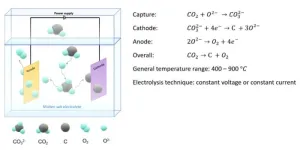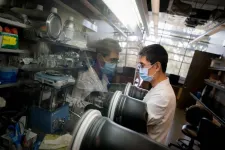(Press-News.org) HOUSTON ― Researchers at The University of Texas MD Anderson Cancer have engineered a new model of aggressive renal cell carcinoma (RCC), highlighting molecular targets and genomic events that trigger chromosomal instability and drive metastatic progression.
The study, published today in Nature Cancer, demonstrates that the loss of a cluster of interferon receptor (IFNR) genes plays a pivotal role in allowing cancer cells to become tolerant of chromosomal instability. This genomic feature may be used to help clinicians predict a tumor’s potential to become metastatic and treatment resistant.
Researchers led by Luigi Perelli, M.D., Ph.D., postdoctoral fellow of Genitourinary Medical Oncology, and Giannicola Genovese, M.D., Ph.D., professor of Genitourinary Medical Oncology, used CRISPR/Cas9 gene editing to create a model that faithfully represents RCC in humans, using cross-species analyses to provide further insights into the mechanisms involved in aggressive kidney cancer evolution.
“Until now, there haven’t been effective experimental models for metastatic renal cancer progression, but we introduced specific mutations that closely mimic the early stages of human cancers to see how tumors evolve and metastasize,” Genovese said. “These tumors become extremely genomically unstable, and, to tolerate this instability, they tend to lose genetic material at a specific site where the interferon genes are located. These insights can help clinicians identify tumors that have the genomic potential to become aggressive.”
Renal cell carcinoma is the most common type of kidney cancer, and patients often are treated effectively with surgery, targeted therapy, immunotherapy or a combination of these treatments. However, up to one-third of these patients will have aggressive disease progression, highlighting a need to understand specific mechanisms that drive metastasis in order to identify more effective therapeutic strategies and to predict treatment responses.
One hallmark of cancer is chromosomal instability, which is associated with resistance to many types of therapy and a poor prognosis. However, it is unclear if specific types of chromosomal abnormalities are involved in driving metastasis and how tumors are able to tolerate them.
The researchers used CRISPR/Cas 9-based genome editing to generate RCC models lacking common tumor suppressor genes. They then targeted cell cycle regulator genes to mimic common chromosomal abnormality associated with metastatic RCC in humans, leading to a phenotype consistent with the human disease. This is the first immunocompetent somatic mosaic model for metastatic RCC, meaning the model has an accumulation of different mutations that result in uncontrolled cell growth but still maintains a functional immune system.
Using genome sequencing and single-cell RNA sequencing to further examine these models, the researchers uncovered molecular drivers of RCC and gained a new understanding of the evolution of chromosomal instability.
Their single cell analyses revealed that a cluster of highly conserved IFNR genes were suppressed in the model, and that this cluster normally functions as a critical gatekeeper, or tumor suppressor, of renal cancer progression.
IFNR gene clusters normally are involved in the immune response. After analyzing various data sets from both mice and humans, the researchers discovered an inverse correlation between the loss of these IFNR genes and aneuploidy, a condition marked by having an abnormal number of chromosomes.
This study suggests that the tumors adapt to high levels of chromosomal instability through the disruption of the IFNR pathway and that this is likely a major biomarker of metastatic potential. It also highlights how renal cancers in different species have followed similar evolutionary patterns that converge around chromosomal instability, which in turn may explain the heterogeneity of these tumors.
In the future, the researchers plan to test drug combinations in these newly generated models to determine how the tumors adapt to various therapies, with the goal of rapidly translating these studies into clinical trials that can help predict treatment response in patients with RCC.
This work was supported by the Fondazione AIRC per la Ricerca sul Cancro (AIRC), the Conquer Cancer Foundation of the American Society of Clinical Oncology, the Kidney Cancer Association, Horizon Europe , the Sheikh Ahmed Bin Zayed Al Nahyan Center for Pancreatic Cancer, the Pancreatic Cancer Action Network, Inc., the Ransom Horne Jr. Professorship for Cancer Research, the Barbara Massie Memorial Fund, MD Anderson’s Moon Shots Program®, the Bruce Krier Prostate Cancer Research Endowment Fund, the Lyda Hill Foundation, the UK Medical Research Council, the National Institutes of Health (NIH) (R01 CA258226-03), and the U.S. Department of Defense (W81XWH-21-1-0950) . A full list of collaborating authors and their disclosures can be found with the full paper here.
Read the full press release on the MD Anderson newsroom.
- 30 -
END
Scientists at the Sainsbury Laboratory Cambridge University (SLCU) have discovered a new molecular signalling pathway, triggered when leaves are exposed to low humidity, that ensures plant roots keep growing towards water.
In dry soil conditions, plants take action to try and conserve water by producing the drought stress hormone abscisic acid (ABA). For decades plant scientists thought that in response to dry soil, ABA was made in the roots and then transported to the leaves. In this root-to-shoot signalling pathway, ABA closes microscopic leaf pores, called stomata, to prevent water loss from leaves. In recent years, scientists ...
New research examining how frequently our bodies produce broadly neutralizing antibodies (bnAbs) capable of thwarting a range of SARS-CoV-2 variants offers clues on the strategy tweaks that could potentially future-proof COVID-19 vaccines.
To counter invading viruses, our body deploys specific antibodies, among them the neutralizing kind targeting the receptor-binding domain (RBD) — the “Velcro hooks” used by pathogens to fasten onto our cells. As SARS-CoV-2 accumulates genetic mutations, new variants emerge donning sneaky disguises to outsmart our defenses. So-called bnAbs are elite neutralizing antibodies that can keep up ...
Carbon dioxide capture, storage, and utilization have been widely researched to achieve CO2 zero emission and resolve climate change issues. Molten salt electrolysis is one promising method to simultaneously capture and convert CO2 into valuable carbon materials and oxygen with high current efficiencies, to provide a promisingly positive cash flow. However, this method still requires investigation for future scale-up applications. A team of scientists reviews the molten salt CO2 electrolysis’s ...
Copenhagen, Denmark: Scientists have discovered that the cells of early human embryos are often unable to repair damage to their DNA. The researchers say that this has important implications for the proposed use of gene editing techniques to remove serious inherited diseases from embryos, as well as for IVF in general.
Presenting the research to the 39th annual meeting of the European Society of Human Reproduction and Embryology (ESHRE) [1], Dr Nada Kubikova from the University of Oxford (UK), said: “Gene editing has the potential to correct defective genes, a process that usually involves first breaking and then ...
Media Inquiries to Laura Muntean, laura.muntean@ag.tamu.edu, 6012481891
Written by Gabe Saldana, 956-408-5040, gabe.saldana@ag.tamu.edu
Texas A&M AgriLife Research scientists and collaborators at Iowa State University have developed a sensor chip that can detect many disease pathogens with 10 times the sensitivity of currently available methods.
The chip also eliminates the need for chemical dye reagents typically used in the diagnostic process. The new technology shows promise for rapid, low-cost point-of-care diagnostic capabilities in plants, foods, animals and humans, including detecting foodborne pathogens, bird flu and COVID-19.
An ...
Copenhagen, Denmark: More than 40% of women who chose to freeze their eggs in their 30s were able to have babies later in life when they returned to the fertility clinic, according to research presented today (Monday) at the 39th annual meeting of the European Society of Human Reproduction and Embryology (ESHRE) [1].
However, many of the women in the study who had frozen their eggs (known as elective oocyte cryopreservation) had not returned to the fertility clinic and many who did return chose fertility treatments that did not involve their frozen eggs.
The research was presented by Dr Ezgi Darici, a clinical fellow at the Centre for Reproductive Medicine at ...
Copenhagen, Denmark: Women treated for childhood Hodgkin lymphoma may face declining fertility at a younger age, according to research presented today (Monday) at the 39th annual meeting of the European Society of Human Reproduction and Embryology (ESHRE) [1].
The research also found that women treated for Hodgkin lymphoma may have to try for longer to become pregnant; however, the majority of women in the study who had tried to become pregnant were ultimately successful.
The research was presented by Dr Katja Drechsel from the Princess Máxima Centre for Paediatric Oncology, ...
A $162 million investment from the U.S. National Science Foundation will drive the creation of advanced materials capable of remarkable things — from being tough enough to withstand the heat of a fusion reactor to processing information at the quantum level. Nine Materials Research Science and Engineering Centers (MRSECs) will each receive $18 million over six years. The centers aim to transform fundamental scientific breakthroughs into tangible benefits for multiple sectors of the U.S. economy and innovations ...
Phenanthridines are heterocyclic compounds consisting of two six-membered benzene rings fused to a six-membered ring containing nitrogen. They are found in many naturally occurring organic compounds known for their anticancer and antitumor properties. Due to their potential medicinal applications, there is a significant interest in synthesizing phenanthridine derivatives in laboratories. A promising synthesis approach involves radical isonitrile insertion to produce imidoyl radical intermediates, which then cyclize to form phenanthridine. However, the exact mechanism of isonitrile insertion is not well understood.
Recently, a team of researchers, led by Associate Professor ...
June 26, 2023-- Reductions in arsenic exposure among the U.S. population were reported for users of public water systems in the South and West, and among Mexican American participants, according to a new study by Columbia University Mailman School of Public Health. Differences in change over time were reported by educational attainment in addition to by region, race/ethnicity, and public water arsenic level. The full findings are published in the journal Environmental Pollution.
The Final Arsenic Rule, first enforced since 2006, reduced the arsenic maximum contaminant level to 10 μg/L in public water systems.
“We ...


